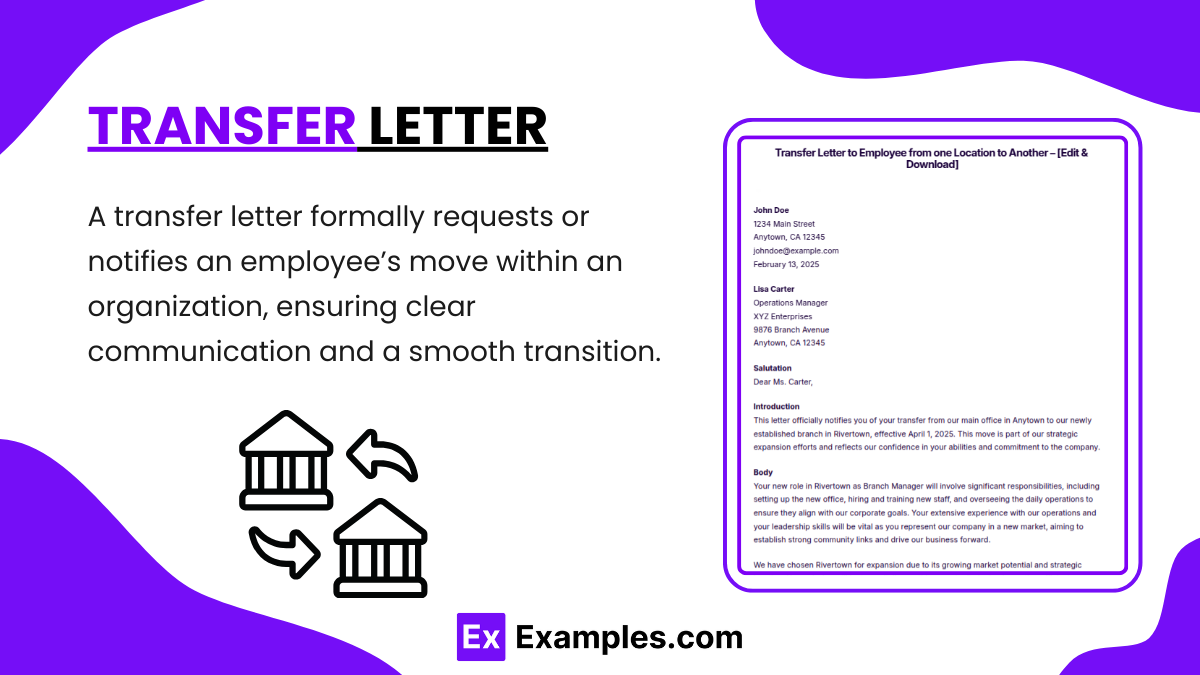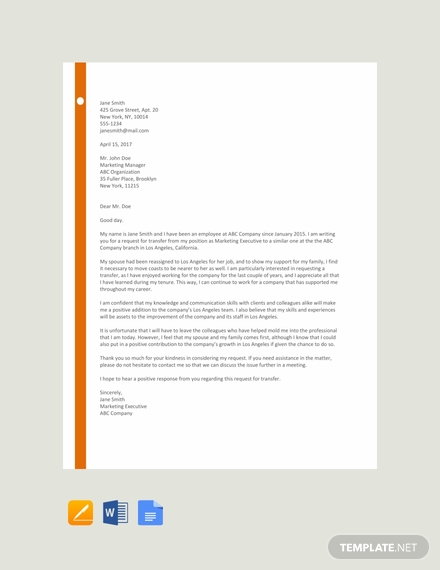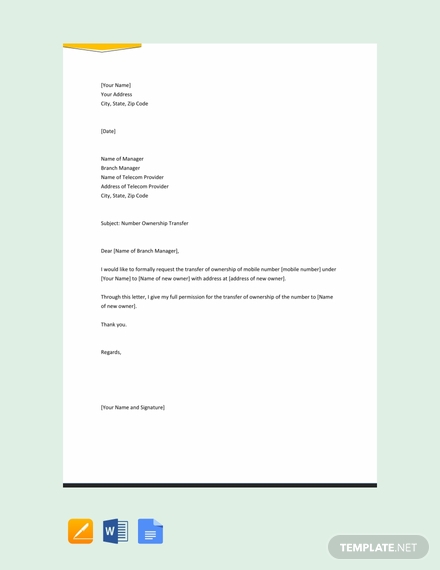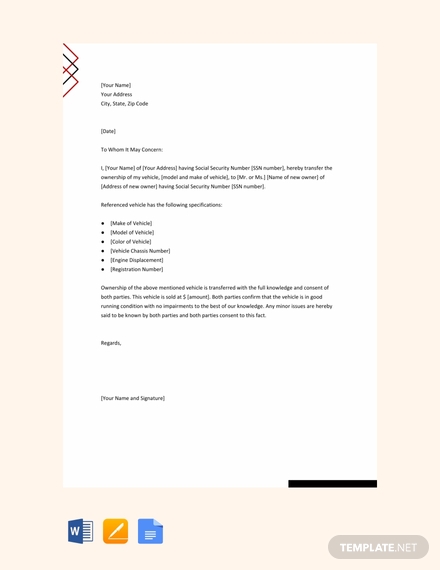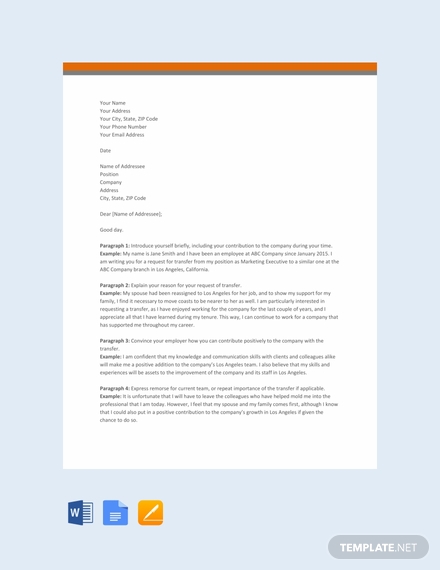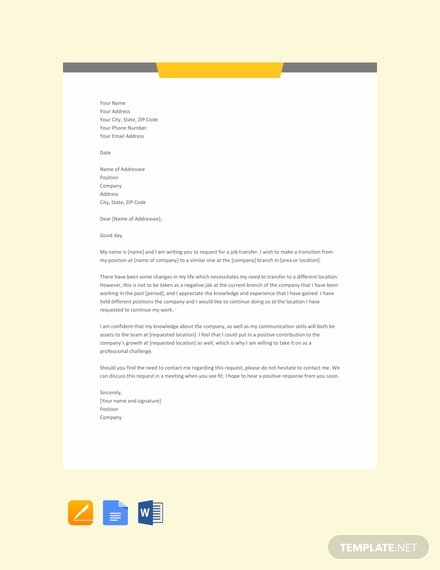20+ Transfer Letter Examples to Download
A transfer letter is a formal request or notification for moving an employee from one department or location to another within the same organization. It plays a crucial role in facilitating smooth transitions, maintaining clear communication between departments, and ensuring that the needs of both the employee and the company are met efficiently. Whether it’s due to personal reasons, organizational restructuring, or career development, a well-crafted transfer letter helps manage expectations and provides all parties with clear instructions and details about the transfer process. This document typically outlines the reason for the transfer, the new role and responsibilities, the effective date, and any other pertinent details to ensure a seamless changeover.
What is Transfer Letter?
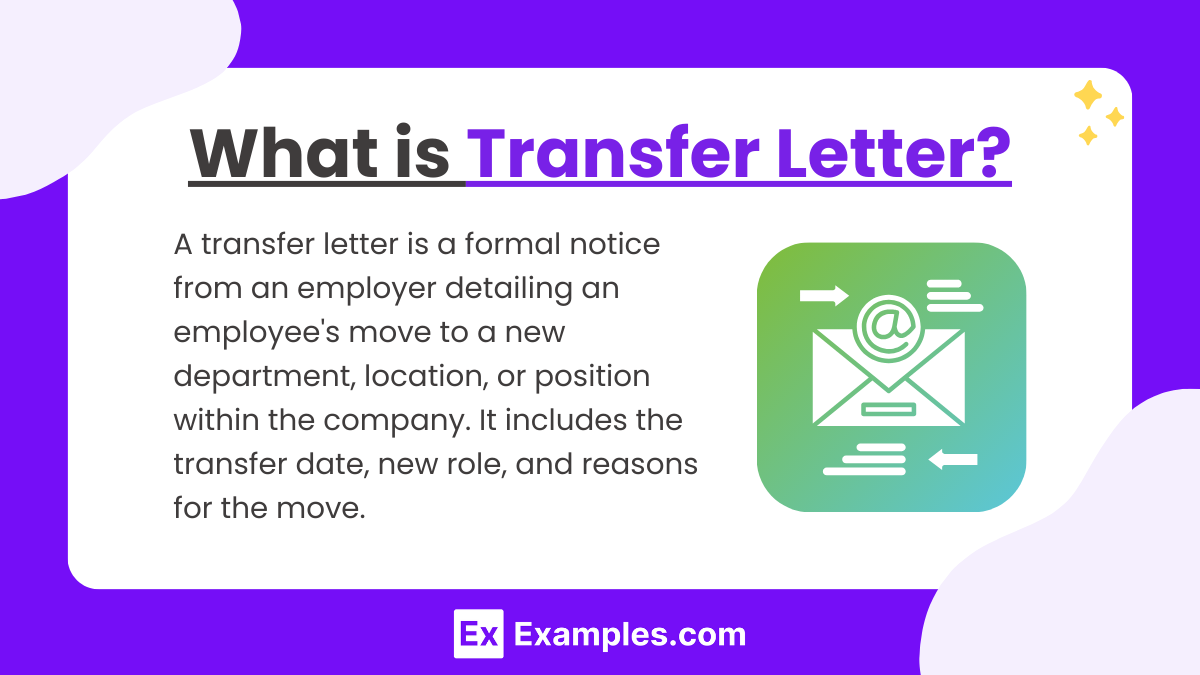
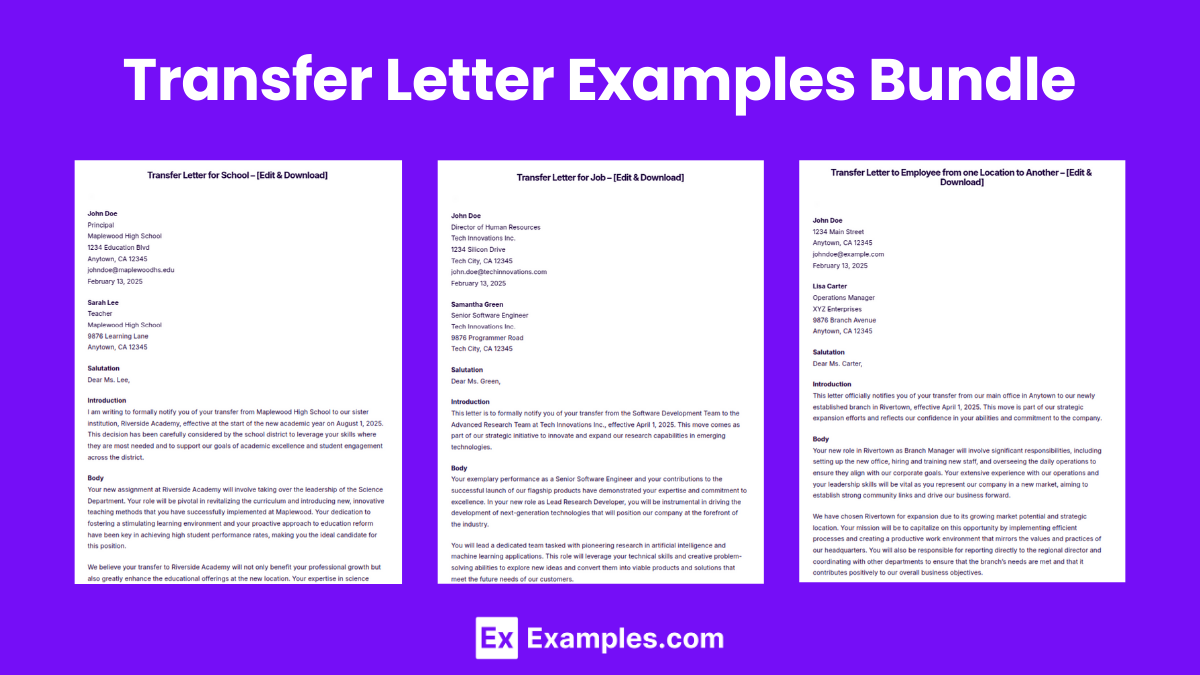
Transfer Letter Examples Bundle
Transfer Letter Format
Sender’s Name
Sender’s Address
City, State, Zip Code
Email Address
Date
Recipient’s Name
Recipient’s Position
Department/Office
Company Name
Company Address
City, State, Zip Code
Salutation
Dear [Recipient’s Name],
Introduction
This letter serves as a formal notification of your transfer from [current department/position/location] to [new department/position/location] effective [date of transfer].
Body
The decision for this transfer has been made due to [briefly state the reason – could be organizational needs, personal request, etc.]. In your new role as [new position], you will be required to [briefly outline expected responsibilities, goals, or tasks]. We believe that your skills and experiences are best suited for this position and that this will be a mutually beneficial move.
Conclusion
Please report to [new supervisor/department/location] on [start date at the new position] at [time]. You will receive further details regarding your new responsibilities and any transitional support in the coming days. We appreciate your cooperation and continued commitment to our company’s goals.
Closing
Sincerely,
Sender’s Signature
Sender’s Name
Position
Department
Transfer Letter Example
John Doe
1234 Main Street
Anytown, CA 12345
johndoe@example.com
February 13, 2025
Jane Smith
Human Resources Manager
ABC Corporation
9876 Branch Avenue
Anytown, CA 12345
Dear Ms. Smith,
This letter serves as a formal notification of my transfer from the Client Services Department to the Project Management Office within ABC Corporation, effective March 1, 2025.
The decision for this transfer is based on our recent internal restructuring and my background in project management. In my new role as Project Manager, I will be responsible for leading project teams, managing client relationships, and ensuring timely delivery of our services. I am eager to bring my expertise in client service and my project management skills to my new position, and I am confident this move will benefit both the company and my professional growth.
I will report to my new supervisor, Mr. Richard Brown, in the Project Management Office on March 1 at 9:00 AM. I look forward to receiving further details about my new responsibilities and the resources that will support my transition to this new role. Thank you for this opportunity and for your continued support.
Sincerely,
John Doe
Project Manager
Client Services Department
Transfer Letter Examples
Transfer Letter to Employee from one Location to Another
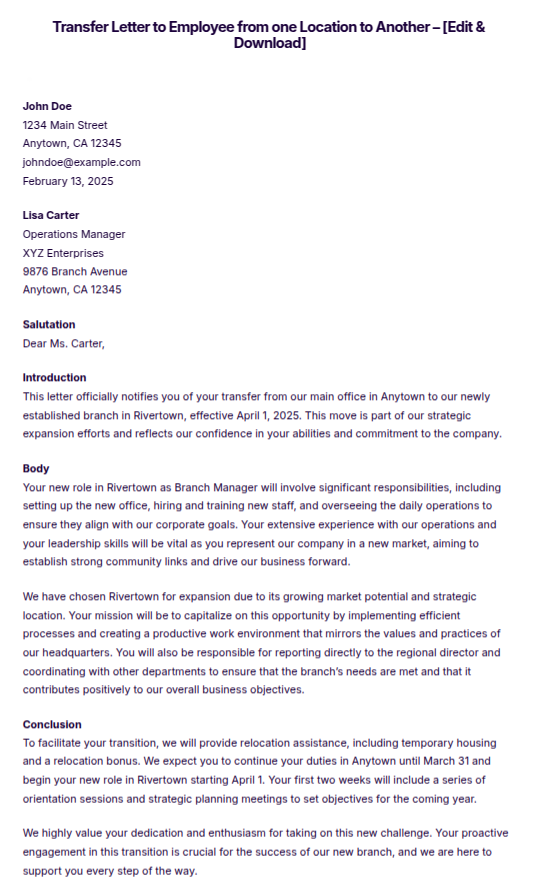
Transfer Letter for School
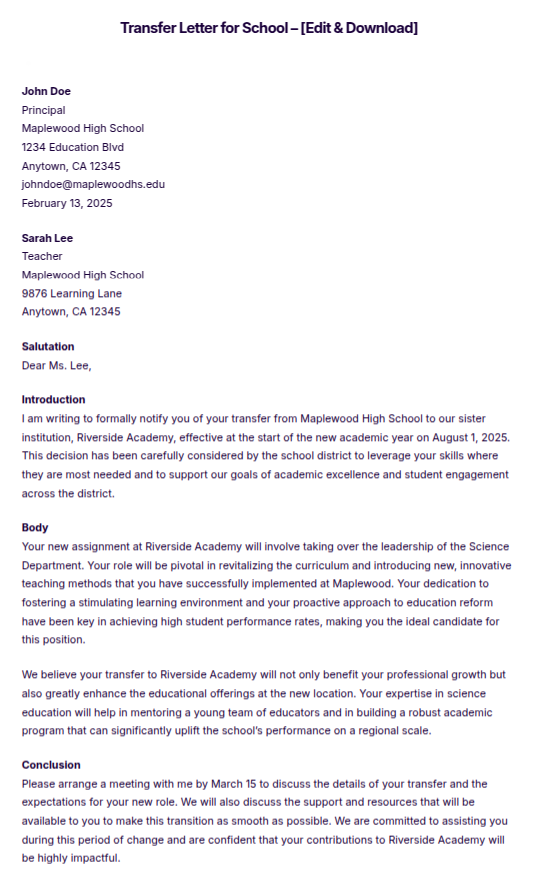
Transfer Letter for Job
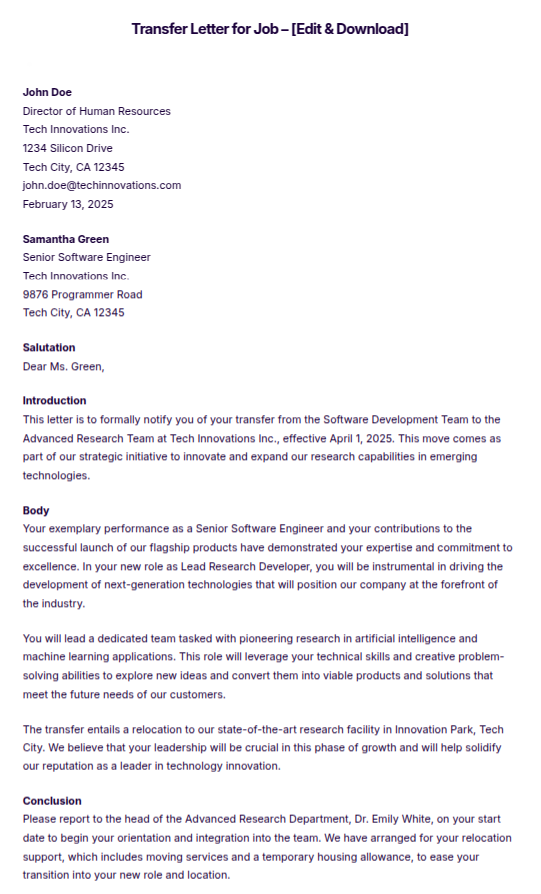
More Examples on Transfer Letter
- Employee Transfer Letter
- Request for Transfer Letter
- Transfer Letter for Bank Account
- Transfer Letter for Government Employee
- Transfer Letter for College
- Transfer Letter for Medical Reason
- Transfer Letter for School from Parents
- Transfer Letter for Vehicle
- Transfer Letter for School Teacher
- Transfer Letter for Nurses
- Salary Transfer Letter
Employee Transfer Letter Template
Transfer Letter Template
Ownership Transfer Letter
School Transfer Letter to Principal
Vehicle Ownership Transfer Letter
Transfer Letter Format
Job Transfer Letter Template
Types of Transfer Letters
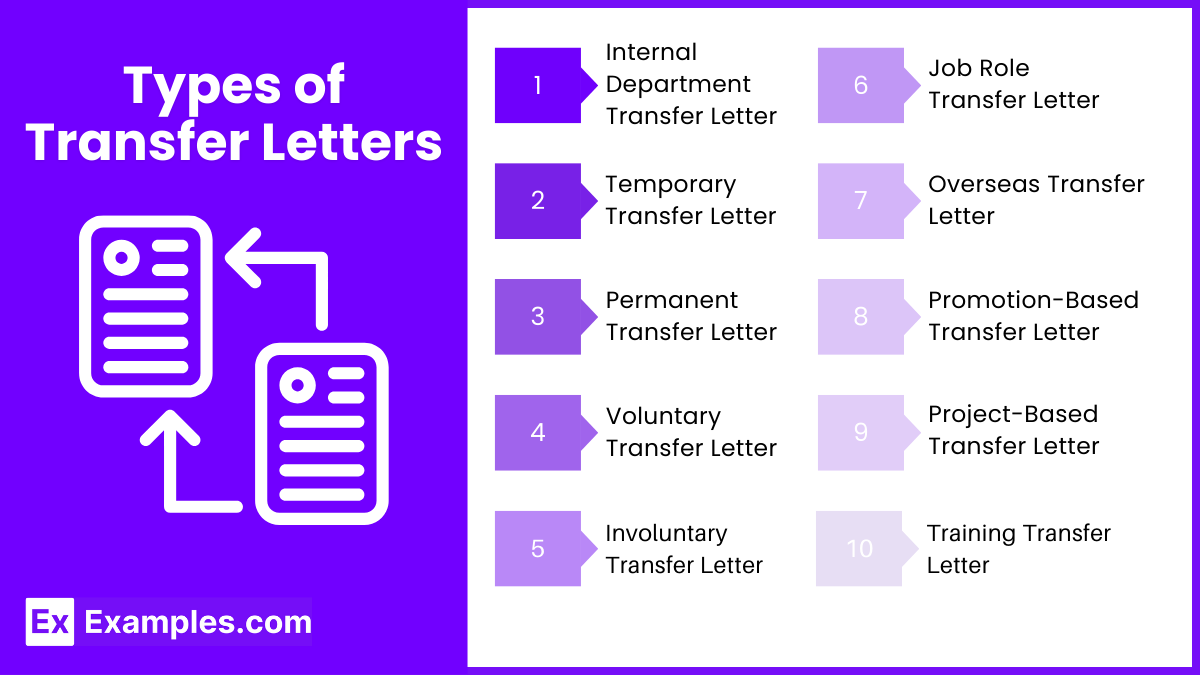
1. Internal Department Transfer Letter
An internal department transfer letter is issued when an employee is transferred from one department to another within the same organization. This type of transfer is often based on business needs, skill development, or promotion opportunities.
2. Temporary Transfer Letter
A temporary transfer letter is given when an employee is relocated to another branch, department, or position for a short period. This can be for training, special projects, or filling in for another employee on leave.
3. Permanent Transfer Letter
A permanent transfer letter is issued when an employee is permanently relocated to a new position, department, or location within the company due to long-term business needs or career advancement.
4. Voluntary Transfer Letter
A voluntary transfer letter is written when an employee requests to be moved to a different department, branch, or location based on personal or professional reasons, such as career growth or relocation.
5. Involuntary Transfer Letter
An involuntary transfer letter is given when the management decides to transfer an employee due to organizational restructuring, downsizing, or business needs. This transfer is mandatory and not initiated by the employee.
6. Job Role Transfer Letter
A job role transfer letter is issued when an employee is moved to a different job role within the same organization. This usually happens when an employee’s skills are better suited for another role or due to internal restructuring.
7. Overseas Transfer Letter
An overseas transfer letter is given when an employee is relocated to a company’s international office. This is common in multinational companies where employees are sent abroad for business expansion, project requirements, or leadership roles.
8. Promotion-Based Transfer Letter
A promotion-based transfer letter is issued when an employee is transferred to a new location or department due to a promotion. This type of transfer usually comes with a change in responsibilities and salary adjustments.
9. Project-Based Transfer Letter
A project-based transfer letter is used when an employee is moved to a different branch, office, or department for a specific project. Once the project is completed, the employee may return to their original position or be reassigned.
10. Training Transfer Letter
A training transfer letter is issued when an employee is relocated temporarily or permanently to another department or location for training purposes. This is often done to upskill employees and prepare them for future roles within the organization.
How to Write an Transfer Letters

Start with a Formal Heading and Address
Include your name, designation, company or institution name, address, and date. Address the letter to the appropriate authority, such as the HR manager, principal, or branch manager.
Clearly State the Purpose of Transfer
Mention whether the transfer is requested or assigned. Specify the reason, such as job relocation, departmental change, or organizational restructuring.
Provide Necessary Transfer Details
Include key information such as the new location, department, position, and the effective date of transfer. If applicable, mention any conditions or special arrangements.
Express Willingness or Request Approval
If it’s a request letter, politely ask for approval and provide justification. If it’s an official transfer notice, assure cooperation for a smooth transition.
End with a Professional Closing
Thank the recipient for their time and support. Sign off with “Sincerely” or “Best Regards,” followed by your name, designation, and signature.
Tips for Writing Transfer Letters
- Use a Professional Tone – Keep the language formal, respectful, and to the point to ensure clarity and professionalism.
- Be Clear and Specific – Clearly mention the reason for the transfer, the new location or department, and the effective date to avoid confusion.
- Provide Supporting Details – If applicable, include any necessary documents, approvals, or justifications to support the transfer request.
- Keep it Concise – Avoid unnecessary details and stick to relevant information to maintain a well-structured and easy-to-read letter.
- Proofread Before Sending – Check for grammar, spelling, and formatting errors to ensure the letter looks professional and error-free.
FAQs
Why is a Transfer Letter Important?
A transfer letter is important as it formally documents the transfer, communicates expectations, and ensures both the employee and employer agree on the transfer terms, minimizing confusion and maintaining organizational structure.
Can an Employee Request a Transfer?
Yes, employees can request a transfer by submitting a formal transfer letter explaining their reason, such as relocation, career growth, or personal circumstances. Approval depends on company policies and operational needs.
How Long Does It Take for a Transfer to Be Approved?
The approval process for a transfer depends on the company or institution’s policies. It can take a few days to weeks, depending on the nature of the transfer and necessary approvals.
Is a Transfer Letter Legally Binding?
A transfer letter itself is not legally binding but serves as formal documentation of the transfer. Employment agreements, policies, and contracts may define legal implications related to the transfer.
Can a Transfer Letter Be Rejected?
Yes, a transfer letter can be rejected if it conflicts with company policies, operational needs, or lacks valid justification. Employers assess feasibility before approving a transfer request based on business requirements and employee eligibility.


